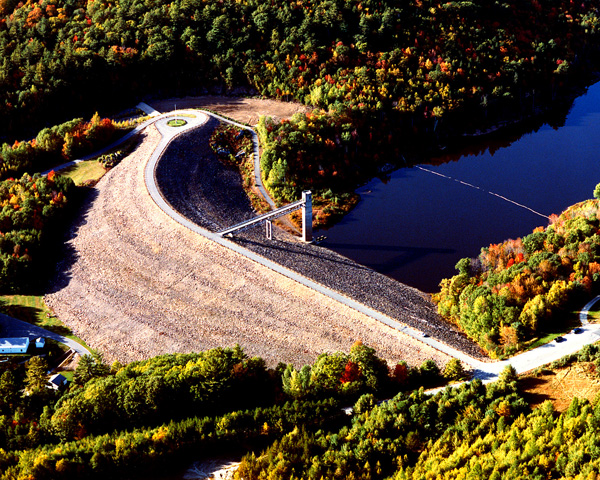The dam at Otter Brook Lake in Keene is located on Otter Brook, a tributary of the Branch River, which in turn is a tributary of the Ashuelot River. From Keene, the project can be reached by traveling two miles east on Route 101 to Branch Road.
From Keene, the project can be reached by traveling two miles east on Route 101 to Branch Road.
In conjunction with Surry Mountain Dam, Otter Brook Lake provides flood protection to Keene, Swanzey, Winchester, and other communities along the Ashuelot River. Along with other Corps dams, Otter Brook Lake helps reduce flooding along the Connecticut River.
Construction of the project began in September 1956 and was completed in August 1958 at a cost of $4.4 million. The project consists of an earthfill dam with stone slope protection 1,288 feet long and 133 feet high; a gated concrete horseshoe conduit, six feet in diameter and 589 feet long; and a chute spillway founded on rock with a concrete weir 145 feet long. The weir’s crest elevation is 21 feet lower than the top of the dam. The work included relocating Branch Road and a portion of Route 9.
Between late March and early April of 1987, two storms dropped over 5.5 inches of rain, causing the first and only spillway discharge at Otter Brook Dam. Fortunately, Otter Brook Dam had stored water long enough for the flood water from uncontrolled areas in the watershed to recede by the time the spillway discharge occurred on April 7, 1987. Although the 750 cfs peak outflow exceeded the 650 cfs channel capacity it did not cause additional downstream damage. It was estimated that Otter Brook Dam alone prevented $3,593,000 in damages from that two storm event. The project has prevented $41.5 million in flood damages since it was built (as of September 2011).
The Reservoir Control Center (RCC), is the "nerve center" for the New England flood control dams. Using radio and satellite communications, RCC constantly monitors river levels and weather conditions that influence flood control decisions.
Park Rangers, in conjunction with RCC, regulate the amount of water released downstream by raising or lowering the three 2.5' X 4.5' gates located in the gatehouse at the dam. In a time of high water, the gates are lowered in order to hold back the water, when downstream river conditions begin to recede, the gates are raised to release the stored water.
For more information, or for recreation opportunities, call (603) 352-4130 or visit the website at: http://www.nae.usace.army.mil/Missions/Recreation/OtterBrookLake.aspx .
- Updated: May 4, 2021